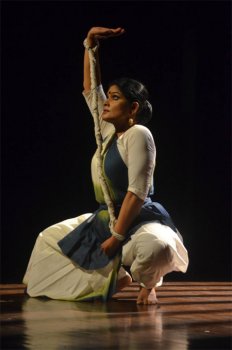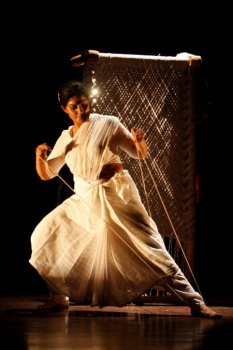
|   |

|   |
Geeta Chandran pays tribute to Gandhiji in 'Gandhi: Warp and Weft' - Dr. Sunil Kothari e-mail: sunilkothari1933@gmail.com October 14, 2012 On the occasion of the143rd birth anniversary of Gandhiji, Geeta Chandran presented her new choreographic work 'Gandhi: Warp and Weft' at Chinmayananda Auditorium on the eve of Gandhi Jayanti. A full house attended the performance and was in for an unusual presentation in dance. Geeta used classical Bharatanatyam vocabulary, free dance movements and also attempted abstract concepts imaginatively.  Photo: Naresh Gulati Then Geeta showed shringara, love suggesting Gandhiji and Kasturba's love play, later on Gandhiji's decision to observe abstinence, and she touched upon multiple faiths, Hindu prayers and Muslim namaz, with small cameos, extending narration to several other issues. In a section on Satyagraha, she moved in various ways, suggesting crowds, young and old, strong and weak, responding to Gandhi's call, using sollus, mnemonic syllables of Bharatanatyam in a specially devised diagonal lighting across the stage. She moved along the dark area, entering the lit up section, to begin other actions, a device which was imaginative and communicative. Dandi march and Salt Satyagraha were suggested with simple gestures. A charpoy was kept as a backdrop, behind which Geeta returned to change the sari and picking up props like plates. The shadows were seen on the charpoy; if the charpoy had a black cloth, with some light for her, the shadow on charpoy indicating changing of costumes etc could have been avoided. Ahimsa section saw her marching, facing aggression, receiving slaps on one cheek, she offering the other cheek, hunger, violence et al using the recorded soundscape for effect and through mukabhinaya - expressions on face - without using words. The commentary through superimposed sound was a clever theatrical device. Very effective, when women as scavengers had to pick up repulsive smelly human excreta, poignantly emphasizing women's plight. The dialogues in Gujarati by women helplessly mumbling about losing money if they did not do the job were heartrending, a pathetic state of existence of poor section of society which has not been eradicated despite all progress. 

Curse of caste, inequality, discrimination, superiority of Brahmin, lowly status of untouchables, placing of metal plates on floor, movements of hurtling blows on stomach, arms akimbo, rolling on floor had intense impact to express various shades of injustice against which Gandhiji fought. They were enacted with economy of gestures. Gandhiji spinning charkha for khadi, his being kept in jail, writing letters, and using khadi thread as a metaphor, thread binding women's hands, a long thread taken from charpoy top ,walking on it step by step, background music with tune of Gandhiji's favourite bhajan Vaishnava jan to tena re kahiye, lying on the floor, taking thread on her body, suggesting division of India, in distance a booming shot of gun, Gandhiji's murder, Geeta wearing thread on her body lying on the floor, lights slowly getting dimmer and fading out. Silence. The audience responded with applause full of admiration for such imaginative treatment of the subject. Within a time span of one hour, packing in a lot, Geeta succeeded in her choreography, showing originality in its artistic treatment. The Rama stuti in the beginning and delineation of shringara, if abbreviated, would help the proceedings of succeeding events. However, the exemplary team work of musicians, projection of sound by Sandip Dutta, lighting by Deepa Dharmadhikari with split second precision, overall stage supervision by Arun Dhavan, specially designed costumes by Sandhya Raman and introduction by Rajiv Chandran, were professional. All deserve congratulations for such a wonderful presentation about Gandhiji. Various agencies including Delhi chapter of Sarvodaya Trust, whose help the artists received, choral singing of bhajans by students of Springdale School deserve appreciation. This work needs repeat performances at many venues including mainstream dance scene and various colleges and schools.  Dr. Sunil Kothari is a dance historian, scholar, author and a renowned dance critic. He is Vice President of World Dance Alliance Asia Pacific India chapter, based in New Delhi. He is honored by the President of India with Padma Shri, Sangeet Natak Akademi award and Senior Critic Award from Dance Critics Association, NYC. He is a regular contributor to www.narthaki.com, the roving critic for monthly magazine Sruti and is a contributing editor of Nartanam for the past 11 years. Post your comments Pl provide your name and email id along with your comment. All appropriate comments posted with name and email id in the blog will also be featured in the site. |